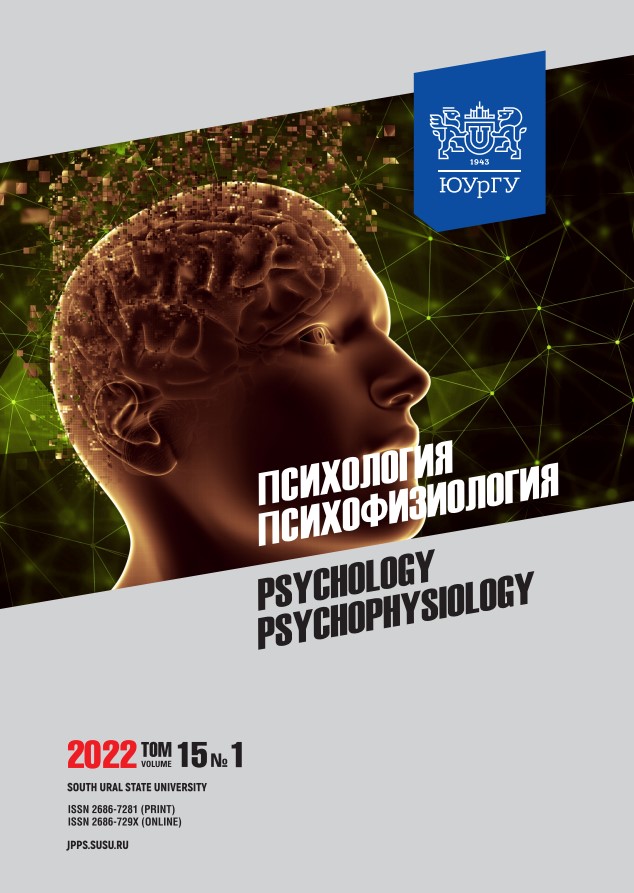Relationship between cyberloafing and media consumption in adolescents
Abstract
Introduction. Information and communication technologies have become an integral part of education and learning. However, the consequences and risks of such integration, including cyberloafing (i.e., the use of Internet technologies during classes for purposes not related to educational activities), have not been thoroughly studied. The paper aims to identify the correlation between cyberloafing and media consumption patterns among adolescents. Materials and methods. The study involved 121 adolescents 13–15 years of age. The cyberloafing scale and the media consumption questionnaire were used for data collection. The results obtained were processed with the Spearman rank correlation coefficient and IBM SPSS Statistics 23.0 software. Results. It was found that during classes teenagers searched for information, which they considered interesting, or communicated online; adolescents described themselves as experienced or advanced Internet users. The most popular sources of information were the Internet, books and television. The use of the Internet correlates positively with online communication, online shopping and search for information not related to educational activities. The volitional control of media consumption correlates negatively with the frequency of online searching, while emotional and cognitive involvement in the media space correlates positively with the frequency of playing online games during classes. Conclusion. The results obtained demonstrate that the patterns of cyberloafing are associated with the quantitative and qualitative features of media consumption among adolescents. Cyberloafing depends on media competence, media perception, and media processing.
Downloads
References
2. Cristia А., Seidl А. Parental Reports on Touch Screen Use in Early Childhood. PLoS One. 2015;10(6):e0128338. DOI: https://doi.org/10.1371/journal.pone.0128338
3. Sivrikova N.V., Ptashko T.G., Perebeynos A.E., Chernikova E.G., Gilyazeva N.V., Vasilyeva V.S. Parental reports on digital devices use in infancy and early childhood. Education and Information Technologies. 2020;25:3957–3973. DOI: https://doi.org/10.1007/s10639-020-10145-z
4. Özcan S., Gökçearslan Ş., Yüksel A.O. An investigation of the relationship between cyberloafing and academic motivation among university students. Küreselleşen dünyada eğitim. 2017:733–742. DOI: https://doi.org/10.14527/9786053188407.52
5. Burleson J., Greenbaum B.E. When Spheres Collide: A Refocused Research Framework for Personal Use of Technology at Work. Communications of the Association for Information Systems 2019;45:411–432. DOI: https://doi.org/10.17705/1CAIS.04523
6. Lim V.K.G. The IT way of loafing on the job: Cyberloafing, neutralizing and organizational justice. Journal of Organizational Behavior. 2002;23(5):675–694. DOI: https://doi.org/10.1002/job.161
7. Durak H.Y. Cyberloafing in Learning Environments Where Online Social Networking Sites Are Used as Learning Tools: Antecedents and Consequences. Journal of Educational Computing Research. 2020;58(3):539–569. DOI: https://doi.org/10.1177/0735633119867766
8. Wu J., Mei W., Liu L., Ugrin J.C. The bright and dark sides of social cyberloafing: Effects on employee mental health in China. Journal of Business Research. 2020;112:56–64. DOI: https://doi.org/10.1016/j.jbusres.2020.02.043
Wu J., Mei W., Ugrin J., Liu L., Wang F. Curvilinear performance effects of social cyberloafing out of class: the mediating role as a recovery experience. Information Technology and People. 2020;34(2). DOI: https://doi.org/10.1108/ITP-03-2019-0105
10. Kim S. Managing millennials personal use of technology at work. Business Horizons. 2018;61(2):261–270. DOI: https://doi.org/10.1016/j.bushor.2017.11.007
11. Koay K.Y. Workplace ostracism and cyberloafing: a moderated–mediation model. Internet Research. 2018;28(4):1122–1141. DOI: https://doi.org/10.1108/IntR-07-2017-0268
12. ONeill T.A., Hambley L.A., Chatellier G.S. Cyberslacking, engagement, and personality in distributed work environments. Computers in Human Behavior. 2014;40:152–160. DOI: https://doi.org/10.1016/j.chb.2014.08.005
13. Ugrin J.C., Pearson J.M., Nickle S.M. An Examination of the Relationship between Culture and Cyberloafing Using the Hofstede Model. Journal of Internet Commerce. 2018;17(1):46–63. DOI: https://doi.org/10.1080/ 15332861.2018.1424395
14. Sivrikova N., Roslyakova S., Sokolova N., Moiseeva E. Assessing of use of the Internet for personal reasons at lessons at school: A Validation of the Cyberloafing Scale. SHS Web of Conferences. 2019;70:06010. DOI: https://doi.org/10.1051/shsconf/20197006010
15. Yilmaz F.G.K., Yilmaz R., Öztürk H.T., Sezer B., Karademir T. Cyberloafing as a barrier to the successful integration of information and communication technologies into teaching and learning environments. Computers in Human Behavior. 2015;45:290–298. DOI: https://doi.org/10.1016/j.chb.2014.12.023
16. Zhang J., Akhtar M.N., Zhang Y., Sun S. Are overqualified employees bad apples? A dual-pathway model of cyberloafing. Internet Research. 2019;30(1):289–313. DOI: https://doi.org/ 10.1108/INTR-10-2018-0469
17. Tanrıverdi Ö., Karaca F. Investigating the Relationships between Adolescents Levels of Cognitive Absorption and Cyberloafing Activities according to Demographic Characteristics. Addicta: The Turkish Journal on Addictions. 2018;5(2): 285–315. DOI: https://doi.org/10.15805/ ad-dicta.2018.5.2.0052
18. Kian-Yeik K. Assessing cyberloafing behaviour among university students: A validation of the cyberloafing scale. Pertanika Journal of Social Science and Humanities. 2018;26(1):409–424.
19. Kramer M. How much does technology weigh on the work-life balance scale? A qualitative study showing the influence of personal technology usage at the workplace on work-life balance. Mens en Maatschappij. 2019;94(1):5–28. DOI: https://doi.org/10.5117/MEM2019.1.002.KRAM
20. Yılmaz R., Yurdugül H. Cyberloafing in IT classrooms: exploring the role of the psychosocial environment in the classroom, attitude to computers and computing courses, motivation and learning strategies. Journal of Computing in Higher Education. 2018;30(3):530–552. DOI: https://doi.org/ 10.1007/s12528-018-9184-2
21. Mercado B.K., Giordano C., Dilchert S. A meta-analytic investigation of cyberloafing. Ca-reer Development International. 2017;22(5):546–564. DOI: https://doi.org/10.1108/CDI-08-2017-0142
22. Joseph G.V., Thomas K.A. Volatility of Digital Technology Enabled Learning- Genimon Vadakkemulanjanal. Test Engineering and Management. 2020;82:832–5839. DOI: https://doi.org/10.6084/m9.figshare.11847258.v2
References on translit
-Copyright (c) 2022 Psychology. Psychophysiology

This work is licensed under a Creative Commons Attribution-NonCommercial-NoDerivatives 4.0 International License.



